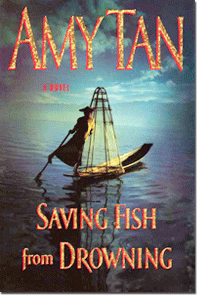
| By EDITH MIRANTE | MAY, 2006 - VOLUME 14 NO.5 |
A touch of
 |
|
Saving Fish from Drowning by Amy Tan. Putnam, New York, 2005. P472 |
Amy Tan (The Joy Luck Club, The Bonesetter’s Daughter) has written a seemingly light comic novel with real political weight. Saving Fish from Drowning (a title that comes from a Buddhist self-justification for eating fish) might not be to everyone’s taste, but those who stick with it will find the author’s good intentions shining through.
The tour group has been a narrative inspiration dating back to Canterbury Tales and Journey to the West. Tan uses the misadventures of a fictional group of travelers as her framework for revealing
The travelers are a m?lange of well-off “been there, done that” types from
The tourists’ glossy obliviousness to their surroundings and each other is a major theme throughout Saving Fish. “People can be so mean and not even know it,” observes the tour’s youngest member, a sulky teenager named Esme, and that is pretty much how these solipsistic pilgrims act, even the inexperienced, undercover human rights activist among them. They are vaguely aware of a tourism boycott of
Bibi Chen explains. “In
The travelers are blind to
Yes, the Karen characters have their problems with reality too. Only the Chinese-American ghost narrator knows all and tells all. Tan’s characters in the book tend toward caricature (a lecherous British dog trainer, cheroot- smoking twin child deities called Loot and Bootie, and a hotelier who propitiates “the Nat in the liquor cabinet”). The effect is often a mixture of Beyond Rangoon and the old American sitcom Gilligan’s Island.
It may seem offensive to some that Tan chose to portray a real country and its real problems in such a frivolous way. But halfway through, during the rather hospitable Karen hostage-taking scene, Tan starts to drive home her political points. A Karen grandmother’s account of the abuse endured by her forest clan reads like an amalgam of various human rights group reports. An American public relations consultant hired by the regime comes up with the slogan “The New Burma is
One can resent Tan for wrapping Burma’s pain in a silly pop-culture package, but if she had concocted a fictional country for her travelers’ tale, there would be hundreds of thousands fewer devoted Tan fans who would know about what actually goes on in “the New Burma.” Tan deserves some praise for bringing